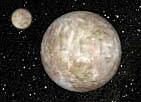Vanth (moon)
 Artist conception of Orcus and Vanth | |
| Discovery | |
|---|---|
| Discovered by | Mike Brown and T.-A. Suer |
| Discovery date | 13 Nov 2005 |
| Designations | |
| Pronunciation | /ˈvænθ/ |
| S/2005 (90482) 1, Orcus I | |
| Adjectives | Vanthian |
| Orbital characteristics[1] | |
| 9030 ± 89 km | |
| Eccentricity | 0.007 ± 0.003 |
| 9.5406 ± 0.0004 days | |
| Inclination | ±21° |
| Satellite of | Orcus |
| Physical characteristics | |
| Dimensions | 378 ± 100 km (Vanth's albedo of 0.12)[1] 276 ± 17 km (assuming equal albedos)[2] |
| Mass | 2–6 kg |
Mean density | ≈1.5 g/cm3 |
| ≈0.11 m/s2 | |
| ≈0.447 km/s | |
| synchronous[3] | |
| Albedo | ≈0.12[1] |
Spectral type | moderately red (optical)[4] |
| 21.97 ± 0.05[4] | |
| 4.88 ± 0.05[4] | |
Vanth, officially (90482) Orcus I Vanth, is the single known natural satellite of the plutino and likely dwarf planet Orcus. It was discovered by Mike Brown and T.-A. Suer using discovery images taken by the Hubble Space Telescope on November 13, 2005.[5] The discovery was announced on 22 February 2007 in IAUC 8812.[6]
Orbit
The moon orbits Orcus "in a tight precise circle", with a period of approximately 10 days.[7] Brown suspects that, like Pluto and Charon, Orcus and Vanth are tidally locked.[7]
Properties
Vanth was found at 0.25 arcsec from Orcus with magnitude difference of 2.7±1.0.[5] Estimates made in 2009 by Mike Brown show that the apparent magnitude of Vanth is 21.97 ± 0.05 which is 2.54 ± 0.01 magnitudes fainter than Orcus.[4] Assuming equal albedos this would mean a diameter of 280 km, or 2.9 times smaller than the primary.[1] However, the dissimilar colors of Orcus (neutral) and Vanth (red) suggest that Vanth could have an albedo a factor of two lower than Orcus.[4] Should Vanth have an albedo of only 0.12, Vanth could be as large as 380 km with Orcus being 760 km in diameter.[1] The mass of Vanth also depends on its albedo and can vary from 3 to 9% of the total system mass.[1][4]
The satellite does not resemble other known collisional satellites because its spectrum is very different of that of primary and thus may be a captured KBO.[7]
Name
Upon discovery, Vanth was issued a provisional designation, S/2005 (90482) 1. On March 23, 2009, Brown asked readers of his weekly column to suggest possible names for the satellite, with the best one to be submitted to the International Astronomical Union (IAU) on April 5.[7] The name Vanth, the winged Etruscan psychopomp who guides the souls of the dead to the underworld, was chosen from among a large pool of submissions. Vanth was the only suggestion that was purely Etruscan in origin. It was the most popular submission, first suggested by Sonya Taaffe.[8] This submission was assessed and approved by the IAU's Committee for Small Body Nomenclature in their March 30, 2010 circular.[9]
The Etruscan Vanth is frequently portrayed in the company of Charun (Charon), and so as the name of the moon of Orcus (nicknamed the "anti-Pluto" because resonance with Neptune keeps it on the opposite side of the Sun from Pluto), it is an allusion to the parallels between Orcus and Pluto. Brown quoted Taaffe as saying that if Vanth "accompanies dead souls from the moment of death to the underworld itself, then of course her face is turned always toward Orcus", a reference to the likely synchronous orbit of Vanth about Orcus.[8]
References
- ^ a b c d e f Attention: This template ({{cite doi}}) is deprecated. To cite the publication identified by doi:10.1051/0004-6361/201117486, please use {{cite journal}} (if it was published in a bona fide academic journal, otherwise {{cite report}} with
|doi=10.1051/0004-6361/201117486instead. - ^ Fornasier et al. (2013)
- ^ Attention: This template ({{cite doi}}) is deprecated. To cite the publication identified by doi:10.1051/0004-6361/201015309, please use {{cite journal}} (if it was published in a bona fide academic journal, otherwise {{cite report}} with
|doi=10.1051/0004-6361/201015309instead. - ^ a b c d e f Brown, M.E.; Ragozzine, D.; Stansberry, J.; Fraser, W.C. (2010). "The size, density, and formation of the Orcus-Vanth system in the Kuiper belt". The Astronomical Journal. 139 (6): 2700–2705. arXiv:0910.4784. Bibcode:2010AJ....139.2700B. doi:10.1088/0004-6256/139/6/2700.
- ^ a b Daniel W. E. Green (2007-02-22). "IAUC 8812: Sats OF 2003 AZ_84, (50000), (55637),, (90482)". International Astronomical Union Circular. Retrieved 2011-07-04.
- ^ Wm. Robert Johnston (2007-03-04). "(90482) Orcus". Johnston's Archive. Retrieved 2009-03-26.
- ^ a b c d Michael E. Brown (2009-03-23). "S/1 90482 (2005) needs your help". Mike Brown's Planets (blog). Retrieved 2009-03-25.
- ^ a b Michael E. Brown (2009-04-06). "Orcus Porcus". Mike Brown's Planets (blog). Retrieved 2009-04-06.
- ^ "Minor planet circular" (PDF). minorplanetcenter.org. 2010. Retrieved 2010-08-08.
